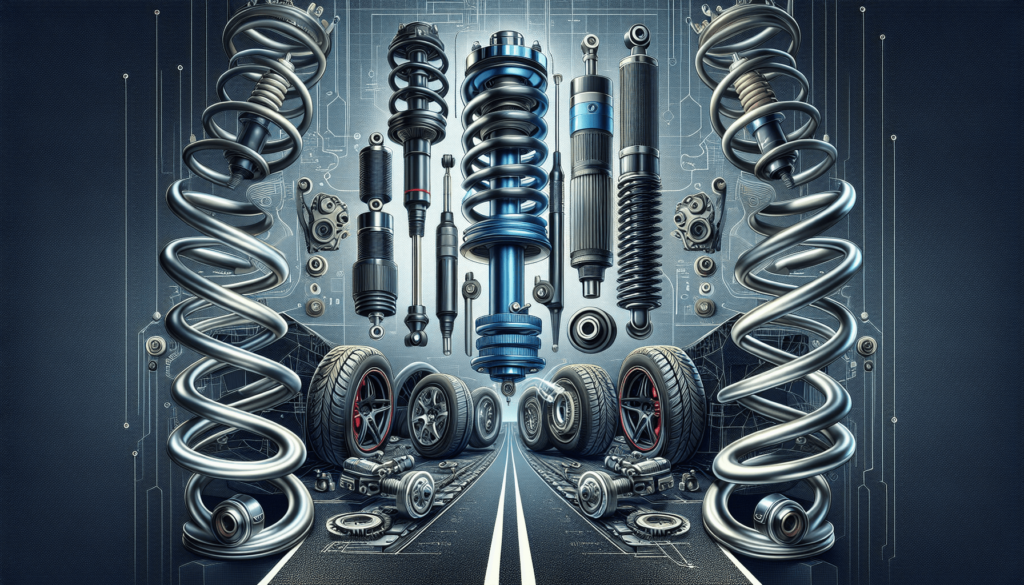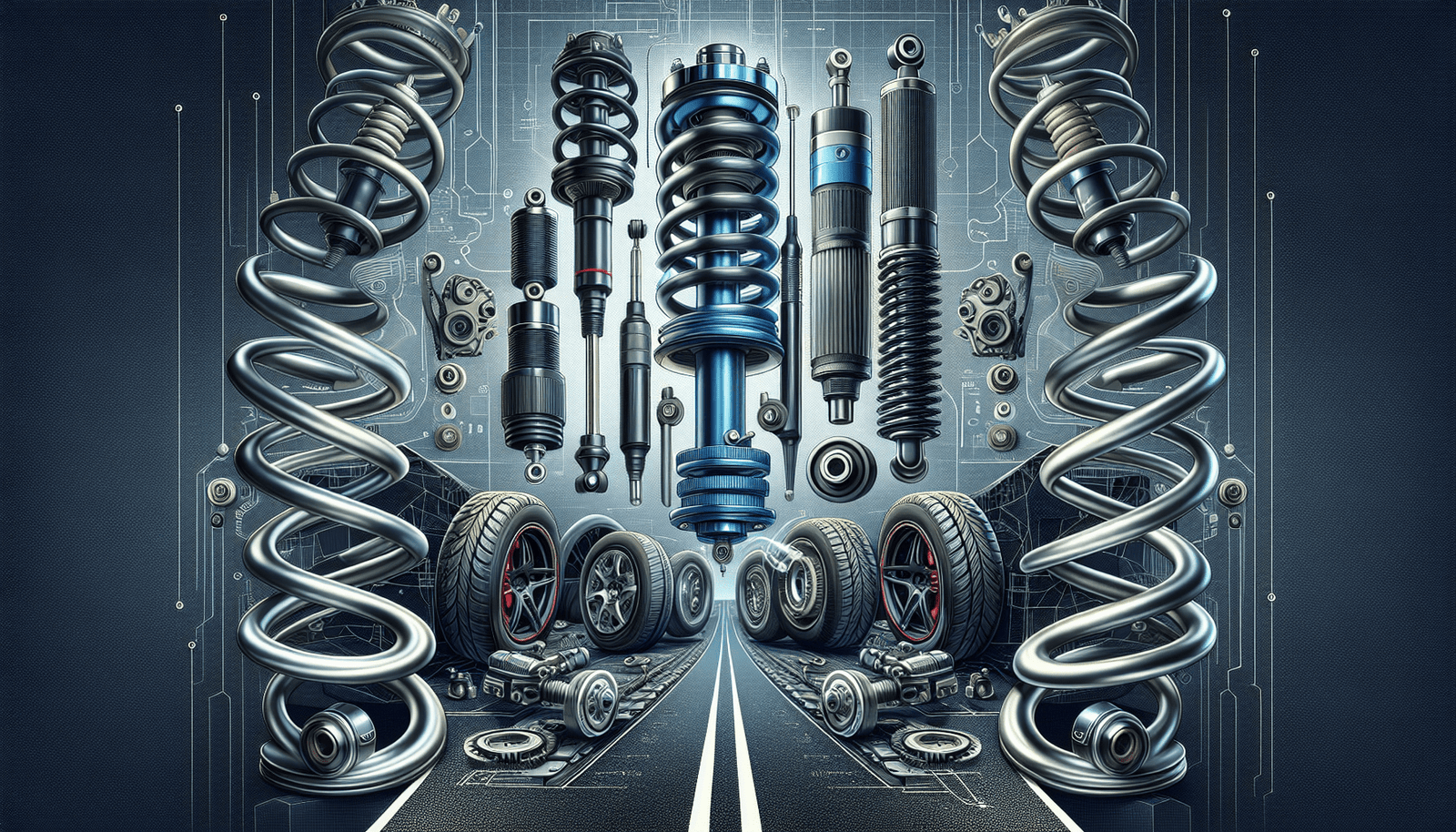Are you unsure about how to select the perfect suspension system for your vehicle? With so many options available, it can be overwhelming. But fear not! In this article, we’ll guide you through the process of choosing the best suspension system for your specific needs. Whether you’re looking to improve your vehicle’s performance or simply enhance your driving comfort, we’ve got you covered. By the end, you’ll have all the knowledge you need to make an informed decision and enjoy a smoother ride. So let’s dive right in and explore the world of suspension systems!
What is a suspension system?
A suspension system is a crucial component of a vehicle that helps in maintaining stability, control, and comfort while driving. Its main purpose is to provide a smooth and controlled ride by absorbing shocks and vibrations from the road surface. A well-functioning suspension system not only enhances the driving experience but also ensures the safety of the vehicle and its occupants.
Definition and purpose of a suspension system
A suspension system consists of various components, including springs, shock absorbers, control arms, and linkages, that work together to support the weight of the vehicle and provide a cushioning effect between the wheels and the chassis. It helps in maintaining traction, steering response, and handling characteristics of the vehicle, regardless of the road conditions.
The primary purpose of a suspension system is to isolate the vehicle’s occupants from the roughness and irregularities of the road surface. It achieves this by allowing the wheels to move up and down independently, reducing the transfer of shocks and vibrations to the cabin. Additionally, the suspension system ensures that the tires maintain maximum contact with the road for improved grip and control.

Types of suspension systems
There are several types of suspension systems available, each designed to cater to different vehicle types, driving styles, and road conditions. The most common types include:
1. Conventional suspension system
The conventional suspension system, also known as a solid axle suspension, is a simple and cost-effective design typically found on trucks and older vehicles. It consists of a solid beam that connects both wheels, allowing them to move together. While this system is durable and capable of handling heavy loads, it lacks the ability to provide independent movement for each wheel, resulting in reduced ride quality and handling.
2. Independent suspension system
The independent suspension system, on the other hand, allows each wheel to move independently from one another. It provides a higher level of ride comfort, improved handling, and enhanced traction. This system is commonly found in modern passenger cars, sports cars, and SUVs. There are various types of independent suspension systems, such as MacPherson strut, double wishbone, and multi-link suspension.
3. Air suspension system
The air suspension system utilizes air springs to support the weight of the vehicle. It offers adjustable ride height, allowing drivers to raise or lower the vehicle for improved ground clearance or aerodynamics. Air suspension systems are commonly found in luxury cars, heavy-duty trucks, and off-road vehicles where the versatility of ride height adjustment is desirable.
4. Coilover suspension system
Coilover suspension combines the coil springs and shock absorbers into a single unit. It offers adjustable ride height, damping, and spring rates, allowing for a more customizable setup. Coilover suspension systems are popular among performance-oriented enthusiasts and are often used in racing applications to achieve optimal handling and cornering performance.
5. Electronic suspension system
Electronic suspension systems utilize sensors and computer-controlled actuators to adjust the damping characteristics of the shock absorbers in real-time. This allows the suspension to adapt instantly to changing road conditions and driving dynamics. Electronic suspension systems are commonly found in high-end luxury cars and sports cars, where the focus is on providing a smooth and controlled ride.
Advantages and disadvantages of each suspension system
1. Conventional suspension system
Advantages:
- Simple and durable design
- Suitable for heavy load-bearing vehicles
- Cost-effective compared to other suspension systems
Disadvantages:
- Lack of independent wheel movement affects ride comfort and handling
- Limited ground clearance and articulation capabilities
2. Independent suspension system
Advantages:
- Each wheel moves independently, offering improved ride comfort and handling
- Better traction and stability, especially during cornering
- Allows for larger wheel travel and articulation, suitable for off-road applications
Disadvantages:
- More complex and expensive compared to conventional suspension systems
- May require more frequent maintenance and repairs
3. Air suspension system
Advantages:
- Adjustable ride height for improved ground clearance and aerodynamics
- Enhanced ride quality and comfort
- Ability to level the vehicle when carrying heavy loads
Disadvantages:
- Higher initial cost compared to traditional suspension systems
- More complex and requires specialized maintenance and repairs
4. Coilover suspension system
Advantages:
- Customizable ride height, damping, and spring rates for optimal performance
- Improved handling, stability, and cornering abilities
- Suitable for both street and track applications
Disadvantages:
- Higher cost compared to stock suspension systems
- May result in a harsher ride quality if not properly adjusted
5. Electronic suspension system
Advantages:
- Real-time adjustment of damping characteristics for optimal ride comfort and handling
- Improved stability and control under varying driving conditions
- Can be programmed for different driving modes (e.g., comfort, sport, eco)
Disadvantages:
- Higher cost compared to conventional suspension systems
- Complex electronics may require specialized maintenance and repairs

Considerations for off-road vehicles
Off-road vehicles require a suspension system that can handle the unique challenges of rugged terrains. Some considerations to keep in mind for off-road applications include:
1. Lift kits and increased ground clearance
Off-road vehicles often benefit from lift kits, which increase the distance between the undercarriage and the ground. This modification allows for improved ground clearance, reducing the risk of damage to the suspension components and maximizing the vehicle’s off-road capabilities.
2. Off-road specific suspension systems
There are suspension systems specifically designed for off-road use, such as long-travel suspension setups and solid axle conversions. These systems offer increased wheel travel, improved articulation, and enhanced durability to withstand the demands of extreme off-road conditions. It is important to choose a suspension system that matches the intended off-road activities.
Performance suspension systems
For enthusiasts seeking enhanced performance and handling characteristics, there are specific suspension options to consider:
1. Sport-tuned suspension systems
Sport-tuned suspension systems are designed for aggressive driving and improved handling performance. These systems usually feature stiffer springs, upgraded shock absorbers, and sway bars that reduce body roll and improve stability during cornering.
2. Adjustable dampers
Suspension systems that offer adjustable damping allow drivers to fine-tune their vehicle’s ride characteristics. By adjusting the damping force, the driver can achieve a balance between comfort and sportiness, depending on their preferences and driving conditions.
3. Stiffer springs
Stiffer springs can help reduce body roll during cornering and enhance responsiveness, especially in performance-oriented vehicles. However, it is important to strike a balance between stiffness and ride comfort, as excessively stiff springs may result in a harsh and uncomfortable ride.
Consulting with suspension experts
When considering a suspension system upgrade or replacement, it is beneficial to consult with suspension experts who can provide valuable insights and guidance. Here are a few avenues to seek expert advice:
1. Mechanics and auto shops
Experienced mechanics and auto shops specializing in suspension work can offer professional recommendations based on your vehicle’s specifications, driving style, and requirements. They have the expertise to assess your suspension needs and suggest suitable options that align with your budget and preferences.
2. Online forums and communities
Online forums and communities dedicated to automotive enthusiasts are an excellent resource to gather information and seek advice. Engaging with fellow enthusiasts and experts in these platforms can provide insights into real-world experiences and recommendations based on specific vehicle models and scenarios.
3. Professional suspension tuners
Professional suspension tuners specialize in optimizing suspension systems for specific vehicles and driving applications. By analyzing various factors, such as vehicle weight, suspension geometry, and intended use, they can recommend suspension setups tailored to your exact requirements. A consultation with a suspension tuner can yield personalized recommendations for maximum performance and overall driving satisfaction.
Researching and reading reviews
Before making a final decision, it is important to research and read reviews about different suspension systems. Here are a few sources to consider:
1. Manufacturer websites
Manufacturer websites provide detailed information about their suspension systems, including specifications, features, and compatibility with various vehicle models. They often include customer testimonials and reviews that can give insight into the performance and reliability of their products.
2. Automotive magazines
Automotive magazines often conduct comprehensive reviews and comparisons of suspension systems, evaluating factors such as ride comfort, handling, and durability. These unbiased reviews can help in assessing the pros and cons of different suspension options and narrowing down the choices.
3. Online customer reviews
Online retail websites and automotive forums feature customer reviews and ratings for a wide range of suspension systems. Reading these reviews can provide valuable insights into real-world experiences and help in making an informed decision based on the feedback of other users who have installed the same suspension system on their vehicles.
Considerations for DIY installation
For those inclined towards performing their own suspension system installation, there are a few important factors to consider:
1. Level of difficulty
Before embarking on a DIY installation, it is important to assess the level of difficulty involved. Some suspension systems may require specialized tools, equipment, and technical knowledge. Be sure to accurately evaluate your mechanical aptitude and capabilities to ensure a successful installation.
2. Tools and equipment required
Proper tools and equipment are essential for a smooth and hassle-free installation. Ensure that you have the necessary tools, including a jack, jack stands, spring compressors, wrenches, and sockets, to safely and effectively complete the installation.
3. Availability of instructions or tutorials
Most reputable suspension system manufacturers provide detailed installation instructions or tutorials that guide you through the installation process. It is important to review these resources thoroughly and follow the recommended steps to ensure a proper and safe installation. Additionally, online video tutorials and user forums can provide additional guidance and tips from experienced enthusiasts who have installed similar suspension systems.
Cost considerations and budgeting
When choosing a suspension system, it is essential to consider both the initial purchase and installation costs, as well as the long-term maintenance and repair expenses. Factors to consider include:
1. Initial purchase and installation costs
Suspension systems can vary widely in price depending on the type, brand, and level of customization. It is important to establish a budget and research options within that range. Additionally, consider any additional costs, such as professional installation fees, alignment services, and potential modifications required for compatibility.
2. Long-term maintenance and repairs
Maintaining and servicing a suspension system is essential for its longevity and optimal performance. It is important to factor in the costs of regular maintenance, such as inspecting and replacing worn-out components, as well as potential repairs in the event of damage or failures. Consider the availability of replacement parts and the reputation of the manufacturer for customer support and warranty coverage.
In conclusion, choosing the best suspension system for your vehicle requires careful consideration of factors such as vehicle type, budget, driving style, road conditions, and specific requirements. Researching different suspension options, consulting with experts, reading reviews, and evaluating the costs will help you make an informed decision that enhances your vehicle’s performance, comfort, and safety. Remember, a well-chosen and properly installed suspension system can transform your driving experience and take your vehicle to new heights.

